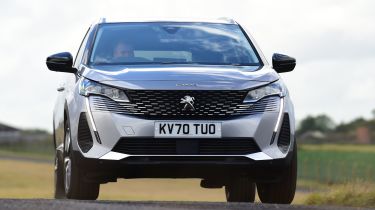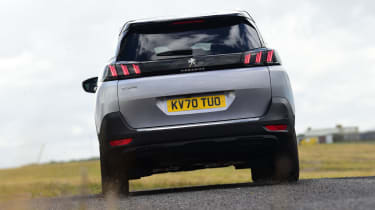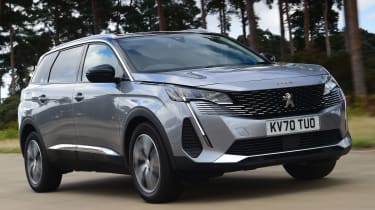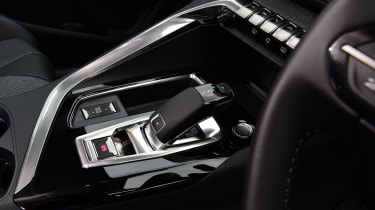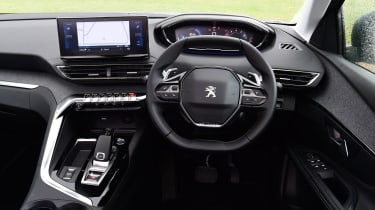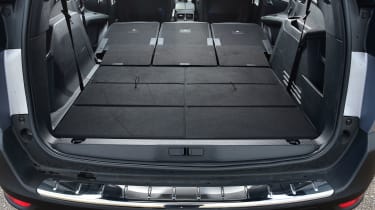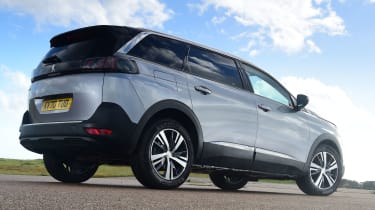Peugeot 5008 (2017-2024) review
The Peugeot 5008 is a stylish family SUV that offers good practicality and a useful third row of seats

Just so you know, this is an older review of the 2017-2024 Peugeot 5008. If you are interested in information about the latest Peugeot 5008, or news of upcoming Peugeot models, please follow the links provided.
Despite the Peugeot 5008 having been around a while now, it still looks fresh in its second generation form. It’s been transformed from a frumpy MPV into a sharp-looking large SUV, sporting a fantastic interior, seven-seat versatility, and a remarkably composed and comfortable ride.
The 5008 makes a good case for itself in petrol form, but it’s in mid-spec diesel guise that we think will make the most sense to buyers. It’s gutsy enough to handle a full complement of passengers and their luggage, offers impressive economy, and is reasonably refined. The lack of any electrified plug-in hybrid option might put company car buyers off, but it’s hard to fault as a family car.
About the Peugeot 5008
Once upon a time, the Peugeot 5008 was for sale as an MPV, but it's now an SUV. Essentially, it's the seven-seat version of the 3008 – another car that used to have some people carrier DNA in its design. Look at the spec sheets, and you'll find that the 5008 has mostly the same engines and trim lines as the 3008, with the seven-seater layout and lack of plug-in hybrid options being the main things that separate the 5008 from the 3008.
Used - available now
The styling of the 5008 is different due to a longer roof line than the 3008, while the extended rear overhang means space for the third row of seats. This also means the 5008 has a bigger boot when the back seats are not in use, which makes it a great choice for families that need a bit more space.
All these attributes mean the 5008 has to take on some strong rivals in the seven-seat family SUV class. Chief among these is the Skoda Kodiaq, joined by the mechanically similar SEAT Tarraco at the front of the class, although the 5008 makes a great alternative option. Elsewhere, there's the Nissan X-Trail and VW Tiguan Allspace, although both these models have smaller rear seats than the 5008. Those looking for greater seven-seat practicality should look at the Hyundai Santa Fe and Kia Sorento.
One word of advice, though. If you're going to be using the third row of seats frequently, then none of these SUVs will be as practical as the French brand’s other seven-seat offering, the Peugeot Rifter and its Citroën Berlingo and Vauxhall Combo Life siblings.
A facelift in 2020 saw some slight exterior styling changes, including a larger grille, revised LED running lights and new headlights. On-board tech was also upgraded with a new 10-inch infotainment screen (on certain models) and an updated 12.3-inch digital instrument cluster.
If the 5008 sounds appealing, then you can get behind the wheel for just under £37,000. That buys you the entry-level 1.2 PureTech 130 three-cylinder turbo petrol in Active trim. Don't worry if the thought of a 128bhp 1.2-litre engine hauling a seven-seat SUV doesn't appeal because the unit is a decent performer around town. It needs revving out with a full load aboard at higher speeds, so if you regularly drive on the motorway, try the slightly more potent 136bhp 1.2 Hybrid model, which provides some mild-hybrid electrical assistance when you need a quick burst of power. Other engines include a 1.5 BlueHDi diesel with 129bhp and a healthy dose of low-rev pulling power to get you up to speed.
All 5008s come with some form of automatic gearbox. The 1.2 PureTech and 1.5 BlueHDi have an eight-speed EAT8 automatic, while the 1.2 Hybrid has a six-speed e-DSC6 dual-clutch automatic. All versions of the Peugeot 5008 are front-wheel drive with no four-wheel drive option available. While that might seem daft on an SUV, Peugeot does offer its Grip Control system as an option, which adapts the traction control system to different surfaces and adds ‘mud and snow’ tyres, which helps give you a bit more traction when you need it.
Active trim is the entry point to the range and is well equipped, but upgrading to the Allure version adds 18-inch alloy wheels, keyless entry, a 10-inch infotainment screen with integrated sat-nav, and ambient interior lighting. Splashing out on the range-topping GT adds adaptive cruise control, blindspot monitoring, front parking sensors, and some Alcantara trim for the dashboard.
Used and nearly new
The Peugeot 5008 has dramatically changed since its introduction in 2009. The first model focused on space and practicality, with little thought about glamour and style. Things have changed with the current model, which has bold styling, a funky cabin and the latest tech.
Peugeot 5008 history
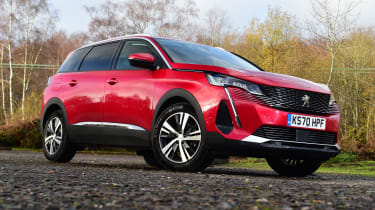
Peugeot 5008 Mk2: 2017-2024
As mentioned above, the 5008 is a very different beast from what you can see below. That’s because the second-generation car is a large SUV, whereas the first generation was an MPV. Earlier versions of this generation came with a greater range of petrol and diesel engines, and some were quite capable of towing a caravan or large trailer. There hasn’t been a plug-in hybrid offered, unlike the 3008. That’s because the battery pack would get in the way of its seven-seat layout, potentially removing the main reason you’d buy a 5008.
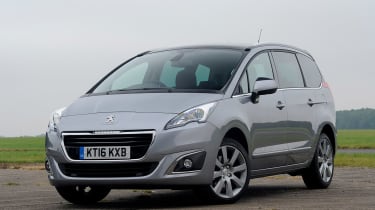
Peugeot 5008 Mk1: 2009-2017
The original 5008 arrived in 2009 as a seven-seater MPV, and was a big step up in quality and driving dynamics over the cars that had gone before. Peugeot introduced its first people carrier, the 806, in 1995, followed by the more stylish 807 in 2003. But each new arrival was trying to get a slice of an even smaller pie, as buyers migrated away from MPVs towards SUVs. It’s no surprise then, that the current 5008 has gone in that direction. Read our full Mk1 Peugeot 5008 buyer’s guide here...
Engines, performance and drive
The Peugeot 5008 isn’t as sharp to drive as a Skoda Kodiaq, but this family SUV does deliver lots of comfort. Its softer suspension set-up and long wheelbase mean the car smothers worn tarmac and cattle grids with aplomb. This suppleness doesn’t come at the expense of body control because it keeps movements in check with a refined, fairly plush feel.
However, this suppleness has a downside, because the Peugeot leans over in corners more than rivals such as the SEAT Tarraco. The small steering wheel makes it easy to turn the 5008 too quickly and upset the car’s balance. Still, there’s a good level of grip, given the concessions to comfort.
There are two automatic gearboxes used in the 5008 range, and both are fine options. The eight-speed EAT8 used in the 1.2 PureTech and the 1.5 BlueHDi is a typical slushy automatic. It’s smooth, but doesn’t provide the quick changes of a dual-clutch equipped Kodiaq or Tarraco. The 1.2 Hybrid uses a dual-clutch, although an electric motor inside the gearbox allows it to power the car for short distances under electric power alone. Based on our experience with this engine in the smaller Peugeot 3008, it should be able to switch between electric and engine power without fuss at lower speeds.
There’s no four-wheel drive model, but some versions have ‘mud and snow’ rated tyres with Grip Control – effectively an advanced traction control system that can work on the driven wheels individually to maximise traction.
Engines, 0-60 acceleration and top speed
The 5008 engine line-up is similar to that in the 3008, with a 1.2 PureTech 130 petrol, a 134bhp 1.2 Hybrid, and a 1.5 BlueHDi 130 diesel.
A big, seven-seat SUV with a 1.2-litre three-cylinder petrol engine might sound like a recipe for slow progress, but the unit’s turbocharger helps to deliver maximum torque of 230Nm from just 1,750rpm, which means the 5008 serves up some pretty decent performance. It’ll accelerate from 0-62mph in a reasonable 10.2 seconds. The extra power of the 134bhp 1.2-litre Hybrid can’t negate the extra 120kg of weight from the hybrid system and batteries, so it takes a little longer to complete the same sprint in 10.4 seconds.
Despite the 1.5 BlueHDi diesel having the same power as the 1.2 PureTech (128bhp) and a bit more torque at 300Nm, it’s the slowest of the 5008 range from 0-62mph, taking 11.8 seconds.
MPG, CO2 and running costs
If fuel economy is your priority, then the Peugeot 5008 for you is the 1.5 BlueHDi 130 diesel because it's the most economical of the lot, with an official WLTP economy figure of 54.1mpg.
The 1.2 Hybrid is almost as economical at 53.3mpg. We saw 45mpg out of a 3008 equipped with this engine, so we’d expect the larger 5008 to get at least 40mpg in the real world, maybe even more if you mostly drive in town and can utilise its electric running as much as possible. We expect the 5008 to be more economical than the equivalent SEAT Tarraco and Skoda Kodiaq, because both have worse official figures.
If you’re on a budget and have to go for pure petrol power, the 1.2 PureTech 130 option is a decent pick. Its official figure is 46.4mpg, which should translate into high-30s in normal driving. Besides, the 1.2 Hybrid costs an additional £1300 over the base 1.2, which is a fair amount of fuel over a typical three-year ownership period, so you’ll need to work out if the extra fuel economy of the 1.2 Hybrid is worth paying extra for in the long run – especially if you don’t cover many miles.
The 1.2 Hybrid’s lower emissions will be useful to company car drivers. It has the lowest emissions of any 5008 at 128g/km, making it several tax brackets lower than the 149g/km 1.2 PureTech. The diesel sits somewhere in between at 131g/km.
Insurance groups
Getting rid of the larger engine options means insurance for the 5008 isn’t as pricey as it used to be. The range starts in group 21 for a 1.2 PureTech and 1.5 BlueHDi in entry-level Active trim, rising to 23 for the 1.2 Hybrid.
That’s on a par with the Tarraco, but less than top models of Kodiaq, which can go as high as group 28 for a four-wheel drive 2.0 TDI Sportline model.
Depreciation
The Peugeot 5008 is a desirable SUV, and our expert data suggests it’ll retain between 46% in 1.5 BlueHDi Active form, and 51% in 1.2 PureTech GT trim after three years and 36,000 miles of ownership. That’s a little behind the 54 per cent predicted for the Skoda Kodiaq 1.5 SE Drive, but better than all versions of SEAT Tarraco.
To get an accurate valuation on a specific model check out our free car valuation tool...
Interior, design and technology
This second-generation 5008 is radically different from its predecessor, with Peugeot repositioning the car as a full-sized seven-seat SUV to meet the growing demand from car buyers.
As part of that transition, the car has moved to the scalable EMP2 platform that underpins the smaller 3008 and cars from sister brand Citroen, such as the C5 Aircross.
The upright grille, detailed headlights and tail lights, the steep windscreen, raised ride height and hidden C-pillars all give the 5008 a distinctive look, and it’s a similar design to the closely related 3008. Cars like the Skoda Kodiaq have a more traditional look, but the 5008 certainly has a distinctive style, and a facelift in 2020 brought further stylistic tweaks to help freshen things up.
On the inside, it’s all good news, as the 5008 has the same high-quality interior as the 3008. The dashboard wraps around the driver, incorporating Peugeot’s infotainment system – an 8.0-inch touchscreen for entry Active versions and a larger 10-inch screen for all other specifications.
The small steering wheel and high-mounted instrument cluster remain, and you get Peugeot’s latest 'i-Cockpit' display, with a 12.3-inch digital screen behind the wheel. Like Audi’s Virtual Cockpit, you can change the layout of the dials, choose what is displayed (and how) or show the sat-nav instructions in front of you if you have an Allure trim model or above.
Apart from some lower-quality materials on the bottom of door cards and the fiddly touchscreen controls for the air-con, the 5008’s interior is among the best in its class. It’s great-looking yet functional. What more could you ask for in a seven-seater car?
Sat-nav, stereo and infotainment
Peugeot’s 12.3-inch dash display and central infotainment touchscreen look snazzy, and all models get Apple CarPlay and Android Auto. Mid-range Allure trim upwards features sat-nav with six months of live updates, providing up-to-the-minute traffic info, local search and weather forecasts.
The facelifted 5008 introduced a larger 10-inch touchscreen – the previous eight-inch unit is now only fitted to base Active trim. The new setup uses much of the same interface, but the screen is larger and has sharper resolution. It’s fairly responsive, but doesn’t load as rapidly as we'd like.
We feel the 5008’s setup is let down by Peugeot’s resistance to using physical climate controls. Adding large panels on either side of the screen to display temperature settings seems like a poor solution. These panels can never be minimised, reducing the size of the rear-view camera display so that it isn’t as clear as it could be. It makes the system feel cheap in an otherwise special cabin. There’s a USB socket in the front, but middle-row passengers only get an extra pair in GT trim.
Practicality, comfort and boot space
The Peugeot 5008 is a seven-seater, so if you only need five seats, you can save some money by opting for the cheaper Peugeot 3008. There’s enough room for five adults to ride comfortably, and a further two can fit in the third row on shorter trips, similar to the amount of room you’ll find in a Skoda Kodiaq.
The 5008 certainly isn’t the best for visibility, as the exterior design has resulted in a lot of rearward blind spots. To that end, you may want to consider the top-spec GT because it comes with blind spot monitoring to warn of approaching traffic along your flank. The rear window is also small and feels far away, so the 5008 isn’t the easiest car of its type to park, as we found during our long-term ownership of one. You’ll rely on the standard rear parking sensors and cameras to miss hitting things when backing up.
At least the driving position is good, as you can see the dials over the top of the steering wheel, unlike the i-Cockpit set-up in some older Peugeot models. It’s comfortable to sit in thanks to the quality seats, and forward visibility is good. Every 5008 has LED headlights as standard, with Allure trim and above adding automatic high beam assist to help illuminate the road ahead better when there aren’t cars ahead of you.
Size
The 5008 is just over 4,641mm long and 1,844mm wide (2,098mm including mirrors), which means it’s a little smaller than the Kodiaq, and it’s slightly lower, too, at 1,646mm. The Peugeot’s wheelbase is longer than the Skoda’s, at 2,840mm, although legroom in both is plentiful. The Skoda has more headroom in the back, especially if you have a 5008 with a panoramic sunroof.
Leg room, head room & passenger space
The middle row sets the 5008 apart from its closest rivals because there are three individual seats, all with Isofix child seat mountings, and they slide and recline for maximum comfort. Thanks to the 5008’s long wheelbase and flat floor, there’s a huge amount of knee room. We would prefer a bit more give in the hard seat base over longer journeys.
The amount of headroom is good, too, although the panoramic roof (standard on GT Line Premium) robs middle-seat passengers of some space.
The third row is more accessible than the seven-seat Kodiaq, because the middle row pushes further forwards. The rearmost seats are primarily designed for kids, but adults can sit there as long as the row in front is slid forward. Both chairs fold into the floor when not in use, and are covered by lift-up panels that mean you can slide longer items in the back much more easily, plus the second-row seats fold flat.
If you need more under-floor storage, the seats can be removed.
Boot
As in most people carriers, there's not a huge amount of boot space in the back of the 5008 with the third row up. A Kodiaq has a little more boot space with all seats up, while a Nissan X-Trail is pretty pokey.
Fold the Peugeot's seats down, and you’ll find 952 litres of space, much more than the Kodiaq’s 720 litres. You can also take the rear seats out completely (they are comparatively light compared to some rivals) which means you’ve got a massive 1,060 litres of space.
Fold the second row of seats down, and the 5008 has 2,150 litres of space, which also beats the Kodiaq’s 2,065-litre capacity. It’s impressive and means the 5008 is one of the roomiest cars in its class.
Towing
The loss of the bigger engines means the towing capacity for the 5008 has reduced considerably. If you’re looking for a tow vehicle in this class, the Kodiaq and Tarraco may be better options.
The 1.5 BlueHDi diesel with 129bhp has a maximum braked trailer weight of 1,200kg, and it only decreases from here. The 1.2-litre petrol model has a 1,100kg towing capacity, while the 1.2-litre Hybrid reduces this even further to 1050kg
Reliability and safety
The Peugeot 5008 hasn't featured in our Driver Power customer satisfaction surveys, but the closely related 3008 has been, and has been a regular on the list of best cars to buy. It’s presently 37th place on that list, with owners praising the car's ride and handling, safety features and infotainment. Peugeot, as a brand, came in ninth spot in the best car manufacturer rankings (out of 32 brands), behind Korean rival Kia, but ahead of Nissan, Skoda, SEAT, Vauxhall, VW, and Renault.
As family transport, the Peugeot will be reassuringly safe, offering autonomous braking and lane-departure warning as standard across the range, while Allure models come with high-beam and lane-keeping assist functions. Range-topping GT adds blind spot detection, as well as adaptive cruise control.
Unfortunately, the 3008 (the car Euro NCAP crash tested and based the 5008’s rating on) was crash tested long ago in 2016, and the test has altered so much since that this rating has now expired. That’s not to say the 5008 wouldn’t protect you well in a collision, but a host of rivals tested under the latest criteria, such as the Land Rover Discovery Sport and Nissan X-Trail, are likely to protect you even better.
Warranty
The Peugeot 5008 has a two-year unlimited mileage warranty from the factory, plus an extra year from the dealer, adding up to a total of three years. That matches the industry standard, although it can't match Kia’s seven-year cover and Toyota's ten-year package.
Servicing
The 1.2 Hybrid needs servicing every 12 months or 12,500 miles, while the 1.2 PureTech requires servicing annually or every 16,000 miles, and the diesel needs checking every 12 months or 20,000 miles.
Peugeot offers fixed-price servicing packages to help spread the cost of scheduled maintenance, and costs around £20 per month.
Frequently Asked Questions
More reviews
Car group tests
In-depth reviews
Road tests
Which Is Best
Most Economical
- Name1.6 Plug-in Hybrid 195 Allure 5dr e-DSC7
- Gearbox typeSemi-auto
- RRP£43,450
